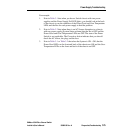
Preliminary
Configure the Ports
SANbox-16HA Fibre Channel Switch
2-20 Installation 59005-03 Rev. A Installer’s/User’s Manual
Tuning Ports for Multi-Frame Sequences
In most circumstances, tuning of an individual port is not desirable, and the default
setting (Normal) should be left unchanged. However, certain Host-Bus-Adapters
(HBA) perform better with tuning. To support optimum performance with these
HBAs, the Switch allows individual ports to be tuned based on the characteristics
of a particular HBA. Tuning modes supported are:
Non-I - Non-Interleaved This option prevents sequences from different sources and
bound for a single destination from being interleaved. Once a sequence has
begun, the Switch will not transmit frames from any source other than the
one which began the sequence. This mode is recommended only for Tachyon-
based adapters being used for IP traffic. It is not recommended in any other
circumstance. If the fabric consists of multiple Switches, Non-I must also be
selected on any Cross Connect port that will be used as a route to the
Tachyon.
Min-I - Minimize-Interleave This option, while not preventing interleaved sequences,
minimizes their extent. Once a sequence has begun, the Switch will continue
to transmit from the same source as long as frames are available for transmis-
sion or end of sequence occurs. If no frames are available for transmission,
then a new source will be started and held until it has no frames to transmit or
end of sequence occurs. This mode is recommended for Qlogic 2xxx HBAs.
Frame-L - Frame Limit This option limits the number of frames that can be transmit-
ted during a single loop tenancy to 32. This option is recommended for JNI
HBAs based on the Adaptec ASIC, and Adaptec HBAs.
Normal No tuning applied. Recommended for all situations not mentioned above.
Use the Port Tuning faceplate in SANsurfer if it is necessary to tune a port for
multi-frame sequences.


















